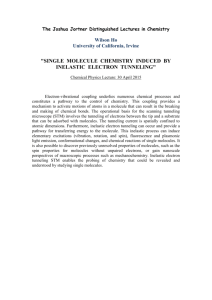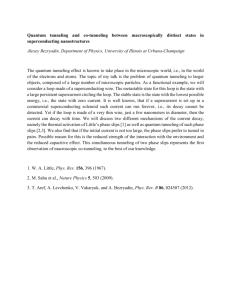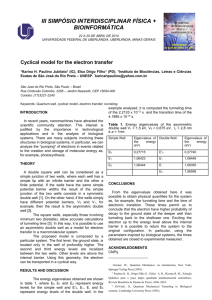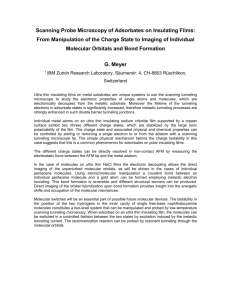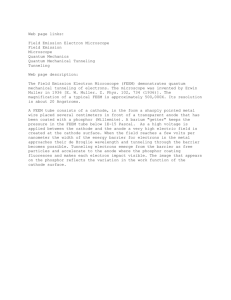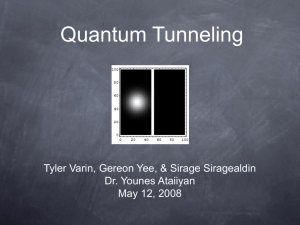Semiclassical Theory for Dissipative Tunneling Through a Molecular Wire
advertisement
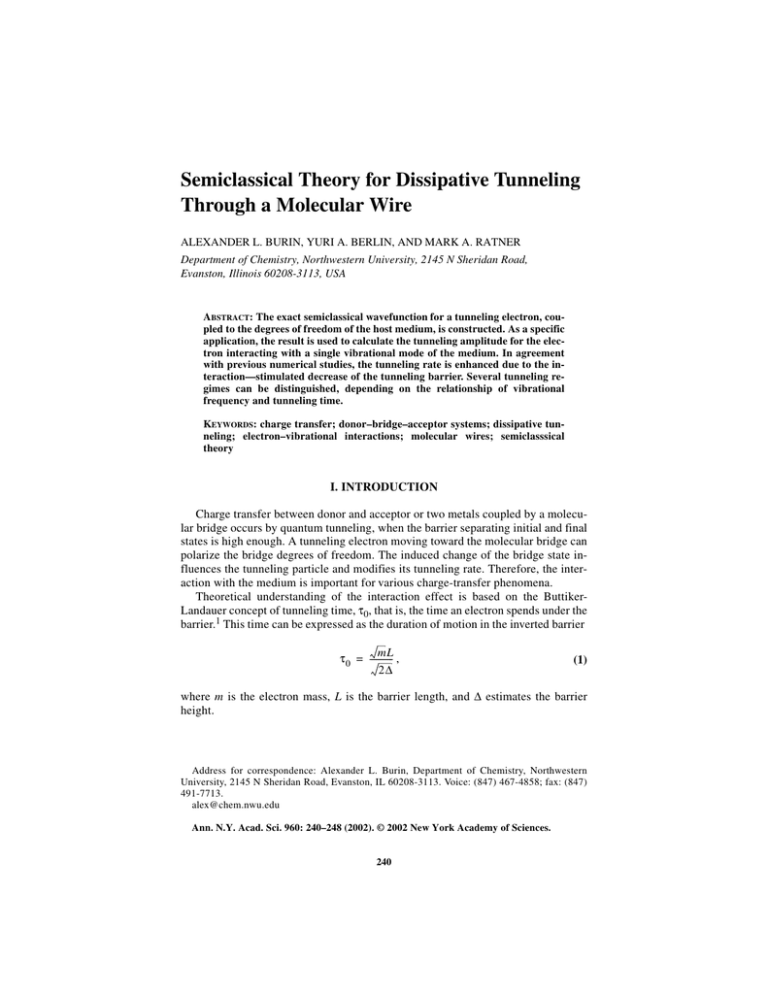
Semiclassical Theory for Dissipative Tunneling
Through a Molecular Wire
ALEXANDER L. BURIN, YURI A. BERLIN, AND MARK A. RATNER
Department of Chemistry, Northwestern University, 2145 N Sheridan Road,
Evanston, Illinois 60208-3113, USA
ABSTRACT: The exact semiclassical wavefunction for a tunneling electron, coupled to the degrees of freedom of the host medium, is constructed. As a specific
application, the result is used to calculate the tunneling amplitude for the electron interacting with a single vibrational mode of the medium. In agreement
with previous numerical studies, the tunneling rate is enhanced due to the interaction—stimulated decrease of the tunneling barrier. Several tunneling regimes can be distinguished, depending on the relationship of vibrational
frequency and tunneling time.
KEYWORDS: charge transfer; donor–bridge–acceptor systems; dissipative tunneling; electron–vibrational interactions; molecular wires; semiclasssical
theory
I. INTRODUCTION
Charge transfer between donor and acceptor or two metals coupled by a molecular bridge occurs by quantum tunneling, when the barrier separating initial and final
states is high enough. A tunneling electron moving toward the molecular bridge can
polarize the bridge degrees of freedom. The induced change of the bridge state influences the tunneling particle and modifies its tunneling rate. Therefore, the interaction with the medium is important for various charge-transfer phenomena.
Theoretical understanding of the interaction effect is based on the ButtikerLandauer concept of tunneling time, τ0, that is, the time an electron spends under the
barrier.1 This time can be expressed as the duration of motion in the inverted barrier
mL
τ 0 = ------------ ,
2∆
(1)
where m is the electron mass, L is the barrier length, and ∆ estimates the barrier
height.
Address for correspondence: Alexander L. Burin, Department of Chemistry, Northwestern
University, 2145 N Sheridan Road, Evanston, IL 60208-3113. Voice: (847) 467-4858; fax: (847)
491-7713.
alex@chem.nwu.edu
Ann. N.Y. Acad. Sci. 960: 240–248 (2002). © 2002 New York Academy of Sciences.
240
BURIN et al.: SEMICLASSICAL WAVEFUNCTION FOR DISSIPATIVE TUNNELING
241
Let the medium degrees of freedom be characterized by the excitation energy E
= hΩM. When the tunneling is relatively fast
ΩM τ0 < 1 ,
(2)
the medium dynamics is too slow to follow the tunneling particle. Slow excitations
suppress the tunneling rate when initial and final equilibrium states of the medium
differ from each other2,3 because of their nonorthogonality. In the opposite case,
ΩM τ0 > 1 ,
(3)
the medium follows the motion of the tunneling particle, forming a polaron. In the
regime ΩMτ0 ∼ 1, inelastic processes during tunneling are most probable.1
Usually, electronic tunneling is considered to be faster than vibronic relaxation
because of the difference in electronic and atom masses.4 Therefore, the dynamic interaction effects should be weak. However, in molecular wires the parameters can be
different. The tunneling time can be increased by the applied voltage, which lowers
the barrier [see Eq. (1)]. Then the current changes significantly due to inelastic processes.5 The slow tunneling regime can also occur for a sufficiently long molecular
bridge. Recent numerical analysis within the tight-binding approach6 shows the energetics of tunneling changes in that regime. The tunneling barrier is lowered by medium modes, since the dynamic interaction assists tunneling.
The analysis of particle tunneling accompanied by the dynamic interaction with
the medium is a hard problem, and the majority of works considering those effects
are numerical (see, e.g., Ref. 6). The development of analytical theory becomes easier, when the semiclassical approach is applicable, that is, the tunneling barrier
height exceeds other energies, characterizing the medium. Note that the semiclassical approach has been used in Refs. 5 and 7 to describe tunneling of electrons interacting with vibrations. Our approach reproduces the results for the wavefunctions
found by Sumetskii.7 It also permits the analysis of tunneling rates for any initial and
final states of any sort of medium not restricted to vibrational degrees of freedom.
The consideration of Ref. 5 has been mostly limited to the case of a slow medium
[see Eq. (2)] and also can be reproduced in our approach. The derivation of the semiclassical wavefunction is given in Ref. 8.
II. SEMICLASSICAL APPROACH
In one dimension the tunneling of a particle interacting with the medium can be
described by the Hamiltonian
2
d
H = – ---------------- + U ( x ) + V M ( x ) + H M .
2
2mdx
(4)
Here the coordinate x describes the motion of the electron of the mass m, U(x) is the
external static potential energy, HM describes the medium degrees of freedom, and
VM(x) describes the interaction between the medium and the electron. The potential
242
ANNALS NEW YORK ACADEMY OF SCIENCES
U ~ ∆ forms the barrier for tunneling from the left lead (x = 0) to the right lead (x =
L), and the barrier height is given by the energy ∆. One-dimensional trajectory can
be used, because the optimum classical path is always one dimensional. This path is
described by the tunneling coordinate, x, while the other two dimensions can be included in the medium degrees of freedom. The interaction is selected to be to equal
zero at the beginning of the tunneling trajectory, V(0) = 0. This can be achieved by
the appropriate definition of the medium Hamiltonian, HM. We are interested in the
solution of the stationary Schrödinger equation defined by the Hamiltonian [Eq. (4)]
with the eigenenergy, E.
One can separate the total tunneling path (0, L) into N small segments (0, x1),
(x1, x2), … ,(xn−1, L). Assuming that the potential energy, U, and interaction with the
medium, V, do not change within each small segment, (xi−1, xi), one can replace them
by mean constants:
˜ (x) = U = U((x + x
U
i
i
i + 1) ⁄ 2) ,
V˜ M ( x ) = V M, i = V M ( ( x i + x i + 1 ) ⁄ 2 ) ,
(5)
xi < x < xi+1.
Then the eigenstates of the stationary Schrödinger equation with eigenenergy E, defined by the Hamiltonian [Eq. (4)] with interactions U and V replaced according to
Eq. (5), can be constructed exactly within each segment (xi−1, xi). They are the products of the eigenstates of the medium |αi,m>, and the semiclassical one-dimensional
“plane waves” with the imaginary momentum exp(±pi,m x), because the domain under the barrier is classically forbidden:
i
i
Ψ m, E = |α i, m⟩ exp ( ± p m, E ( x – x i ) ) ,
ˆ ) |α ⟩ = E |α ⟩
( Vˆ M, i + H
M
i, m
i, m i, m
i
p m, E =
(6)
( 2m ) ( – E + U i + E i, m ) ∼ ( 2m ) ( – E + ∆ ) .
The common solution within the segment i can be written as
i
|Ψ E⟩ =
i−
i
i+
i
∑ ( cE, m |αi, m⟩ exp ( –pm, E ( x – xi ) ) + cE, m |αi, m⟩ exp ( +pm, E ( x – xi ) ) ) .
(7)
m
For reasons of certainty we consider the eigenstate under the barrier as the continuation of the left lead state mostly occupying the space x < 0. Then the wave function
should decrease exponentially under the barrier. Within the semiclassical approximation we keep only the decreasing term in Eq. (7), which corresponds to the exponential tail of the semiclassical state
i
ΨE =
i
i
∑ cE, m |αi, m⟩ exp ( –pm, E ( x – xi ) ) .
m
(8)
BURIN et al.: SEMICLASSICAL WAVEFUNCTION FOR DISSIPATIVE TUNNELING
243
This approximation is justified by the high tunneling barrier ∆ ∼ 1–2 eV with respect
to the interaction with the medium, defined by the reorganization energy ER ∼ 0.1–
0.5 eV.
To construct the eigenstate under the barrier the solutions (8) can be expanded8
towards the whole set of N segments starting with the initial point x = 0 and going to
the end point x = L using the continuity requirements. Finally we arrived at the compact expression for the particle and medium wavefunction8
τ
–1
Ψ M ( x ( τ ) ) = exp ( – S 0 ( τ ) )T exp – ∫ dτ′V̂ M ( τ′, – i ( τ′ – τ ) ) Ψ M ( x = 0 ) ,
0
(9)
V̂ M ( τ′, t ) = exp ( itH M )V M ( τ′ ) exp ( – i tH M ) ,
where τ and τ′ stand for the imaginary time of underbarrier motion, related to the
underbarrier position as
x
τ =
2m dx
-,
∫ --------------------------------------------------(– E + U(x) + E )
(10)
M0
0
where EM0 is the energy of the media at the beginning of tunneling. Below we take
it equal to the ground state energy since the case of low temperatures will be studied.
Interaction VM(τ) is defined as a function of coordinate at the appropriate tunneling
time τ. The classical under barrier action is calculated neglecting the interaction with
the medium; the symbol T−1{…} stands for the imaginary time τ descending ordered
tunneling exponent. To describe the whole tunneling process one needs the eigenfunction (9) at the end of the tunneling barrier x = L, or at the total tunneling time
L
τ0 =
2m dx
,
∫ ----------------------------------------------– E + U(x) + E
0
(11)
M0
Assume that the initial state of the medium is |α, 0⟩ and final state is |β, L⟩. The matrix element for the tunneling processes accompanied by the transition of medium
from the state |α⟩ to the state |β⟩ can be expressed as
τ αβ = t 0 exp ( – S 0 ( τ ) ) ⟨ β, L Aˆ α, 0⟩ ,
τ0
ˆA = T –1 exp – dτ′V̂ ( τ′, – i ( τ′ – τ ) ) .
∫
M
0
(12)
Here t0 is some characteristic preexponent for the semiclassical tunneling matrix element between right and left electronic states, if the bridge is considered as the per-
244
ANNALS NEW YORK ACADEMY OF SCIENCES
turbation (see, e.g., Ref. 3). The operator  describes the evolution of the medium
during tunneling.
In the molecular wire there are no interactions with the medium at the beginning
and at the end of tunneling
VM(0) = VM(τ0) = 0.
(13)
Therefore we can use the same medium bases α for initial and final states in Eq. (12).
The coherent tunneling occurs without change of the medium state, with the conservation of the classification index α. Accordingly, the coherent tunneling can be expressed as (assuming initial thermal equilibrium)
τ αβ
⟨
τ0
= t 0 exp ( – S 0 ( τ ) ) T exp – ∫ dτ′V̂ M τ′, τ′ – τ
0
⟩
,
(14)
T
where averaging is made over the Boltzmann distribution of medium states for the
given temperature, T.
III. A VIBRONIC JUNCTION RESULT
We will apply the result [Eq. (14)] to the model of electron tunneling through a
long molecule, connecting two metal leads under small bias voltage. Usually the Fermi levels of metals are located within the forbidden band of the bridge, and the energy difference between the Fermi energy and the lowest unoccupied molecular level
forms the tunneling barrier. The height of that barrier ranges from several electron
volts for σ-bond molecules to an almost vanishing barrier in carbon nanotubes. We
consider the barrier ∆ to be sufficiently large to apply a semiclassical formalism.
For the small applied voltage one can use the squared coherent tunneling amplitude [Eq. (14)] to describe the tunneling rate (see Ref. 3). To consider the effect of
electron vibration interaction, we keep only one significant optic mode. Certainly,
accurate theory should treat all interactions. Our purpose is to demonstrate the main
effect of vibrations on the tunneling, which is clear within the framework of the
single-mode model. The generalization to interaction with many modes is straightforward.
The computation of the coherent tunneling amplitude [Eq. 14] can be performed
exactly for the interaction with vibrations. Our calculations for the low-temperature
case yield
τ
τ
0
τ′
Ω ( τ′ – τ″ )
1
,
t = t 0 exp ( – S 0 ( τ ) ) exp ------------- ∫ dτ ′γ ( τ′ ) ∫ dτ ″γ ( τ″ )e
2MΩ
(15)
where γ(τ) is the electron vibration interaction constant along the tunneling trajectory, M is the mass of the vibration mode, and Ω is the frequency of vibrations. We
BURIN et al.: SEMICLASSICAL WAVEFUNCTION FOR DISSIPATIVE TUNNELING
245
used the important property of a molecular wire junction [Eq. (13)] that the interaction is zero before and after tunneling [γ(τ0) = γ(0) = 0].
Equation (15) allows the important conclusion that the vibrational effect under
the conditions of a vibronic molecular wire always enhances the tunneling. This
agrees with the conclusion of recent numerical studies5,6 for the tight-binding problem. To check that our result is not an artifact of the continuous model, we have calculated the perturbative coherent tunneling amplitude for the simple tight-binding
model of two levels i and f coupled through one excited intermediate state e with vibrational interaction involved
2
2
+
+
+
+
+
2u
p
H = – b ( c i c e + c e c i + c e c f + c f c e ) + ( ∆ – γu )c e c e + -------- + MΩ ----- ,
2
2M
(16)
where the operators p and u stand for the vibration coordinate and momentum, respectively. The perturbative tunneling amplitude in terms of the tunneling parameter
b connecting initial and final states of the problem [Eq. (16)] can be expressed as
∆0 = b
2
∞
∫ dte
– t∆
exp ( a [ e
– hΩt
0
– ( 1 – hΩt ) ] ) ,
(17)
2
γ
a = ------------------- .
3
2hMΩ
Dimensionless parameter A shows the interaction strength. It is defined by the ratio
of the effective reorganization energy and the energy of vibrations. Equation (17) is
equal to the standard perturbative result b2/∆ in the absence of the interaction a = 0.
It increases when the strength of the electron vibration interaction a increases, because the factor in the exponent in Eq. (17), e−x − 1 + x > 0 at all positive x = hΩt.
Therefore, the tunneling amplitude is expected to increase due to the electron vibration interaction, even within the three-site tight-binding model.
The increase of the tunneling amplitude is caused by the reduction of the tunneling barrier by the reorganization energy ER = hΩa [see Eq. (17)]. We have computed
the effective tunneling barrier in three different regimes of tunneling using the semiclassical wavefunction, Eq. (9). The results are shown in FIGURE 1 (see Ref. 8 for
details). The strongest reduction of the barrier occurs in the regime of slow tunneling
[Eq. (3)], since the vibration adiabatically follows the electron in that case. As seen
from FIGURE 1, the barrier does not vanish at the end of tunneling, which means that
the optimum regime corresponds to some energy dissipation, given by the final value
of the barrier with respect to its initial value. In agreement with the Buttiker-Landauer theory,1 maximum dissipation occurs in the intermediate tunneling regime,
Ωτ0 ∼ 1. This dissipation describes heating of the molecular wire due to tunneling
and the underbarrier friction force acting on the moving charge.
Thus, we have developed a semiclassical theory, describing tunneling charge, interacting with the medium. We have demonstrated that the interaction with vibrations reduces barrier and increases the tunneling rate. In addition, it leads to some
246
ANNALS NEW YORK ACADEMY OF SCIENCES
FIGURE 1. Dependence of the tunneling barrier reduction on the position of the electron under a rectangular barrier for fast, intermediate, and slow tunneling regimes. Tunneling barrier is taken to be ∆ = 1 eV. Calculations are performed for the interaction depending
on the tunneling time (coordinate) as γ(τ) = γ0sin(πτ/τ0).8
energy dissipation. Our conclusions agree with the previous numerical studies. We
have used the approach of continuous media. The generalization to the relevant tightbinding model is to be studied, based on the generalization of the Buttiker-Landauer
tunneling time concept for the discrete problem.9
ACKNOWLEDGMENTS
We thank Abe Nitzan for the valuable suggestion to verify the semiclassic approach results for a simple tight-binding model, and Rudy Marcus, Kolya Prokofev,
and Vladi Mujica for helpful discussions. This work was sponsored by the chemistry
divisions of the NSF and ONR, by the MURI Program of the DoD , and by the Molecular Electronics Program DARPA.
REFERENCES
1. BUTTIKER, M. & R. LANDAUER. 1982. Phys. Rev. Lett. 49: 1739.
2. LEGGETT, A.J. et al. 1987. Rev. Mod. Phys. 59: 1.
3. KAGAN, YU & N.V. PROKOFEV. 1992. In Quantum Tunneling in Condensed Media, Yu.
Kagan and A.J. Leggett, Eds. Elsevier. Amsterdam.
4. PAZ, E. & B. LAIKHTMA. 1999. Phys. Rev. B 59: 15854.
5. NESS, H. & A.J. FISHER. 1999. Phys. Rev. Lett. 83: 452.
BURIN et al.: SEMICLASSICAL WAVEFUNCTION FOR DISSIPATIVE TUNNELING
247
6. YU, Z.G., D.L. SMITH, A. SAXENA & A.R. BISHOP. 1999. Phys. Rev. B 59: 16001;
BONCA, J. & S.A. TRUGMAN. 1997. Phys. Rev. Lett. 79: 4874; THOMPSON, K. & N.
MAKRI. 1999. Phys. Rev. E 49: R4729; SEGAL, D. & A. NITZAN. To be published.
7. SUMETSKII, M. YU. 1985. Sov. Phys. JETP 62: 355.
8. BURIN, A.L., YU. A. B ERLIN & M.A. RATNER. 2001. J. Phys. Chem. A 105: 2652.
9. NITZAN, A. et al. 2000. J. Phys. Chem. B 104: 5661.
